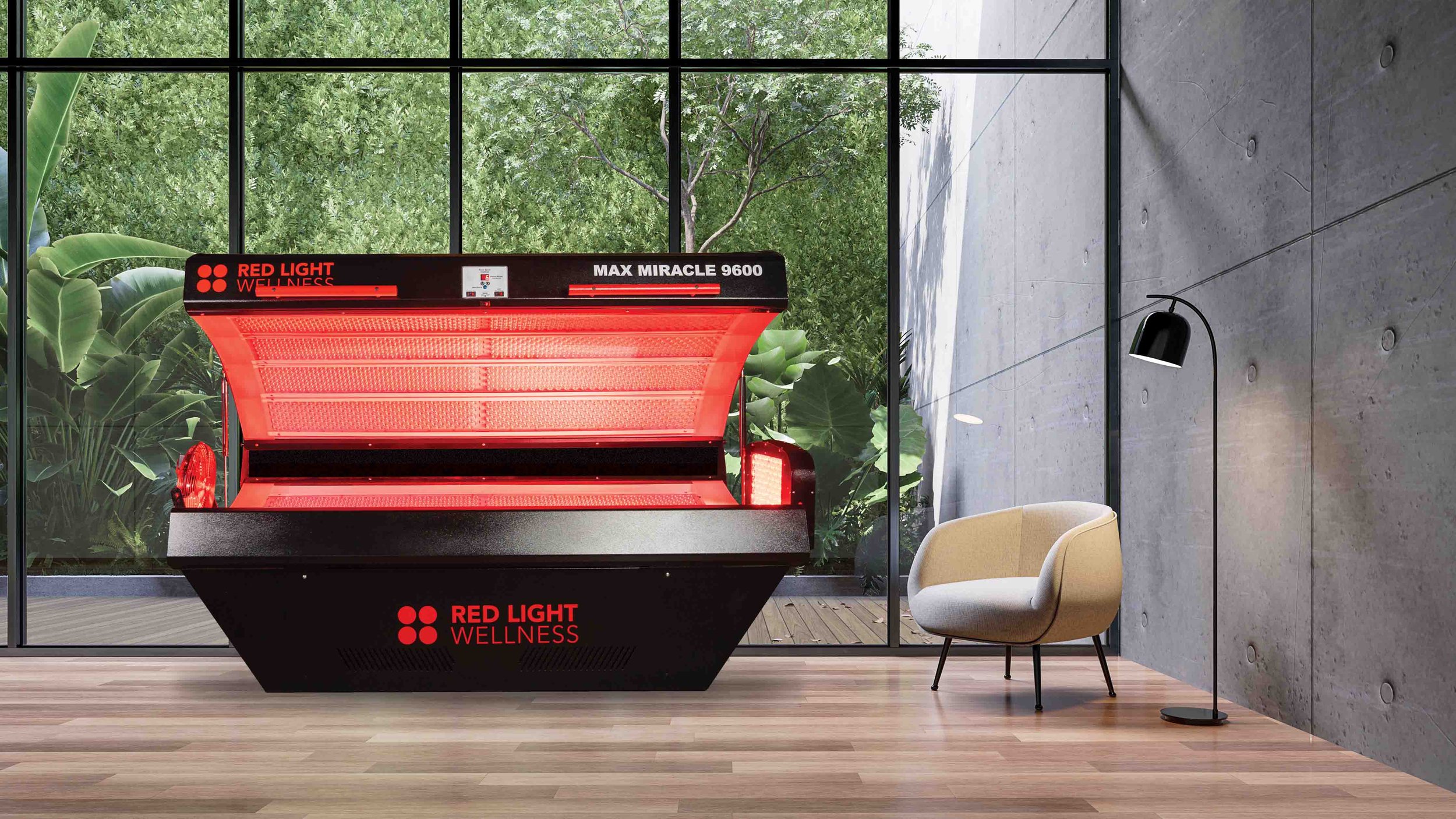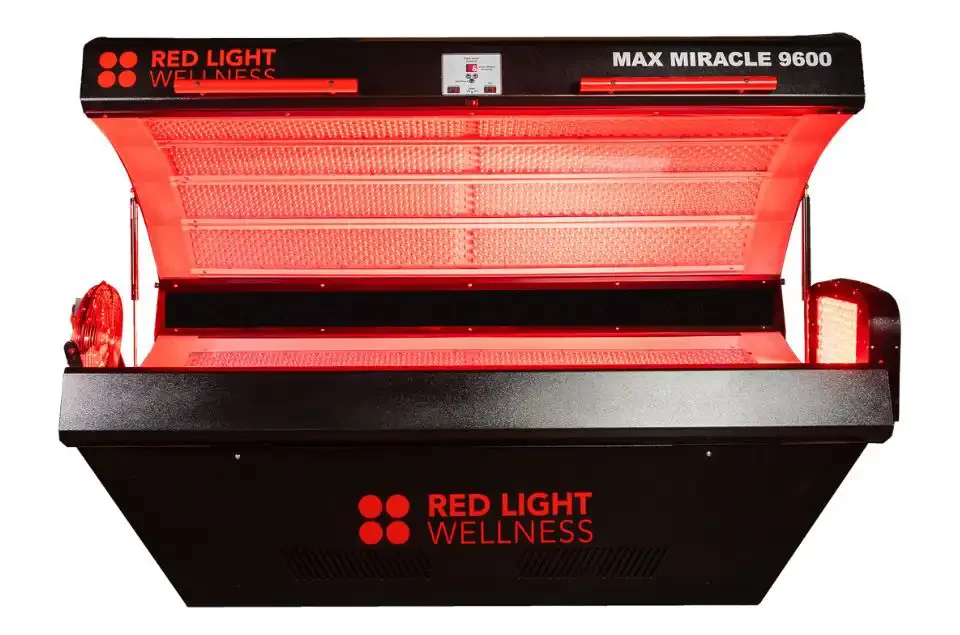Red Light Therapy (Photobiomodulation)
Red light therapy is the smarter way to improve skin quality, support recovery, and elevate client outcomes—without surgery, drugs, needles, or downtime.
Red light therapy is photobiomodulation that uses non-UV light to influence mitochondrial pathways. Results build over time with consistent, evidence-aligned dosing. This therapy uses non-UV red and near-infrared light to influence cellular processes tied to skin quality and recovery. Red light therapy is also called low-level light therapy, low-power laser therapy, phototherapy, and “cold” laser.

FDA Class II • Pro Support • Training & Room Layouts • U.S. Service & Warranty
Red light therapy is rooted in mitochondrial mechanisms
Red light therapy is thought to act on mitochondria and cytochrome-c-oxidase, which modulate nitric-oxide signaling, microcirculation, and collagen remodeling. These biologic pathways help explain why cosmetic, recovery, and comfort goals often require consistent, cumulative dosing over weeks rather than instant results.
Red light therapy dose is quantitative (irradiance × time = fluence)
Red light therapy is dose-dependent: irradiance (mW/cm²) × time (s) = fluence (J/cm²). Responses often follow a biphasic “sweet spot”: too little under-performs; too much may diminish gains. Use device protocols to match dose to the goal and the treatment distance.
Example target ranges (non-prescriptive):
Skin appearance (face): lower irradiance, shorter sessions to reach modest fluence.
Recovery/adjunctive comfort goals: moderate irradiance, carefully timed sessions.
Scalp support: moderate irradiance, consistent cadence over months.
Red light therapy dose is quantitative (Dose Planner)
Dose = irradiance (mW/cm²) × time (s) → fluence (J/cm²). Responses often follow a biphasic “sweet spot.” Use device protocols; this table is educational, not medical advice.
| Goal | Common Wavelength Set | Typical Session Cadence | Target Fluence Band* | Notes |
|---|---|---|---|---|
| Skin appearance (face) | 630–660 nm + 810–850 nm | 1–3×/week, 8–12 weeks | Lower band | Shorter sessions; follow eye-protection guidance per device. |
| Recovery / adjunctive comfort | Red + near-infrared pair (e.g., 635/850 nm) | 2–3×/week, 6–8+ weeks | Moderate band | Consistency matters; avoid overdosing (biphasic response). |
| Scalp support | Red + near-infrared pair | 2–3×/week, 12–24 weeks | Moderate band | Patience required; effects are cumulative over months. |
*Educational only; follow your device’s clinical guidance. Keep treatment distance consistent when planning dose.
Red light therapy benefits are indication-specific (what to expect)
Red light therapy is explored for cosmetic skin goals, adjunctive comfort and recovery, and scalp support. Red light therapy is cumulative, dose-dependent, and sensitive to treatment distance and consistency. Red light therapy works best when expectations match the indication and when dose (irradiance × time = fluence) stays within protocol.
Evidence at a Glance
• Dermatology uses show promising signals in small, varied studies.
• Adjunctive comfort/recovery (e.g., knee OA) shows low to very-low certainty improvements vs sham.
• Outcomes depend on wavelength and dose (irradiance × time = fluence).
Skin appearance (tone, texture, clarity)
Red light therapy is a non-UV, noninvasive option that targets fine lines, dullness, uneven tone, and serves as an adjunct for acne care.
• Cadence: 1–3 sessions per week for 8–12 weeks, then maintenance.
• When you may notice changes: a subtle glow and softness in weeks 1–4; clearer texture and tone by weeks 4–8+ with consistent dosing.
• Good fit: clients seeking gentle support alongside skincare routines.
Pain & recovery (adjunctive comfort goals)
Red light therapy is a supportive add-on for general recovery and comfort when layered into broader rehab or wellness plans.
• Cadence: 2–3 sessions per week for 6–8+ weeks; keep distance and timing consistent.
• When you may notice changes: incremental comfort signals over several weeks; results are dose- and adherence-dependent.
• Good fit: clinics integrating PBM to complement existing recovery modalities.
Hair/scalp support
Red light therapy is a cosmetic support for thinning hair as part of multi-modal routines (expect patience and protocol consistency).
• Cadence: 2–3 sessions per week for 12–24 weeks, then maintenance.
• When you may notice changes: gradual signals over months; consistency matters more than intensity.
• Good fit: clients willing to follow long-horizon programs.
Red light therapy safety is high with sensible precautions
Red light therapy is generally well-tolerated when used as directed; it is non-UV and noninvasive. Protect eyes when instructed. People using photosensitizing medications or with light-sensitive conditions should consult a clinician. Long-term safety data remain limited, and misuse may irritate skin or eyes.
Use caution if:
You take photosensitizing medications or have a light-sensitive condition.
You have unmanaged infection or open wounds on the treatment area.
You are pregnant—discuss any therapy with your clinician first.
Red light therapy devices are not all the same (how to choose)
Red light therapy devices differ by wavelength sets (common pro combinations include ~630–660 nm and ~810–850 nm), irradiance (power density), coverage uniformity, thermal management, and session time to reach dose. These factors change the experience and the outcomes.
Compare your options:
Red light therapy treatments are cumulative (frequency & timelines)
Red light therapy is typically scheduled 1–3 sessions per week for several weeks, then tapered to maintenance. Cosmetic changes often appear over weeks to months; comfort/recovery goals vary by case and adherence. Insurance coverage is uncommon; confirm out-of-pocket costs beforehand.
Quick timeline (typical, not medical advice):
Weeks 1–4: subtle softness, glow, or comfort signals for some users.
Weeks 4–8: visible texture/clarity changes for consistent users.
Weeks 8–12+: consolidation; transition to maintenance cadence.
Red light therapy evidence highlights (what studies report)
Red light therapy is supported by peer-reviewed studies across cosmetic skin appearance, adjunctive comfort and recovery, and scalp support. Red light therapy is associated with improvements in tone, texture, and clarity in cosmetic contexts. Red light therapy is reported to support joint and soft-tissue comfort when paired with established care plans. Red light therapy is linked to positive scalp metrics in programs that emphasize consistent dose and cadence.
Red light therapy study patterns often show better results when wavelength sets are defined, dose (irradiance × time = fluence) is controlled, treatment distance is fixed, and sessions are delivered on schedule. Red light therapy results tend to build over weeks to months and persist with maintenance.
How to read red light therapy research (simple guide)
Red light therapy is easier to evaluate when you look for five things:
Wavelength pairs,
Irradiance (mW/cm²),
Fluence (J/cm²),
Treatment distance and session length,
Clear outcomes and follow-up.
Red light therapy works best for readers—and for clients—when clinic sessions match the dose used in successful studies.
-
Red light therapy is generally well-tolerated when used as directed; protect eyes as instructed and consult a clinician for light-sensitive conditions or medications
-
Most programs schedule 1–3 sessions weekly for several weeks, then adjust to maintenance; timelines vary by goal, device output, and dose consistency.
-
Results are cumulative. Some cosmetic changes appear within weeks; other goals may take months, depending on dose, device, and adherence.
-
No. Wavelengths, irradiance, coverage uniformity, and time-to-dose differ, which affects experience and outcomes.
-
Follow device instructions. Providers commonly shield eyes during facial sessions or whenever brightness is uncomfortable.
-
Effective ranges are typically red and near-infrared (~600–1100 nm). Many professional systems pair ~630–660 nm with ~810–850 nm to span superficial and deeper targets.
Frequently Asked Red Light Therapy Questions
Red light therapy next steps (choose your path)
Red light therapy is easier to implement with pro guidance—compare devices, review specs, or book a demo with our team.
References
Hamblin MR. Mechanisms and mitochondrial redox signaling in photobiomodulation. Photochem Photobiol. 2018;94(2):199–212. doi:10.1111/php.12864.
Zein R, Selting W, Hamblin MR. Review of light parameters and photobiomodulation efficacy: dive into complexity. J Biomed Opt. 2018;23(12):120901. doi:10.1117/1.JBO.23.12.120901.
Chung H, Dai T, Sharma SK, Huang YY, Carroll JD, Hamblin MR. The nuts and bolts of low-level laser (light) therapy. Ann Biomed Eng. 2012;40(2):516–533. doi:10.1007/s10439-011-0454-7.
Huang YY, Sharma SK, Carroll J, Hamblin MR. Biphasic dose response in low level light therapy—an update. Dose-Response. 2011;9(4):602–618. doi:10.2203/dose-response.11-009.Hamblin.
Huang YY, Chen ACH, Carroll JD, Hamblin MR. Biphasic dose response in low level light therapy. Dose-Response. 2009;7(4):358–383. doi:10.2203/dose-response.09-027.Hamblin.
Oliveira S, Andrade R, Valente C, et al. Effectiveness of photobiomodulation in reducing pain and disability in knee osteoarthritis: a systematic review with meta-analysis. Phys Ther. 2024;104(8):pzae073. doi:10.1093/ptj/pzae073.
Fan T, Li Y, Wong AYL, et al. A systematic review and network meta-analysis on the optimal wavelength of low-level light therapy in treating knee osteoarthritis symptoms. Aging Clin Exp Res. 2024;36:203–. doi:10.1007/s40520-024-02853-0.
Stausholm MB, Naterstad IF, Joensen J, et al. Efficacy of low-level laser therapy on pain and disability in knee osteoarthritis: systematic review and meta-analysis of randomised placebo-controlled trials. BMJ Open. 2019;9:e031142. doi:10.1136/bmjopen-2019-031142.
Karu TI. Mitochondrial signaling in mammalian cells activated by red and near-IR radiation. Photochem Photobiol. 2008;84(5):1091–1099. doi:10.1111/j.1751-1097.2008.00394.x.
Maghfour J, et al. Photobiomodulation CME Part I: overview and mechanisms (dermatology perspective). J Am Acad Dermatol. 2024;[CME review]. doi:10.1016/j.jaad.2024.02.019.







